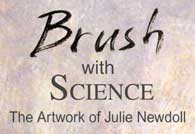

 View Portfolio |
 Inside Time |
 Shows |
 About/Contact the Artist |
The Tale of the Senses; Sense of SmellSmelling is somewhat like seeing, in that we recognize the patterns that scents make when they stimulate the cells which receive odors. There is a field of olfactory neurons inside the nose which capture scents using receptors at the ends of cilia which project out and capture scent molecules as they float by. These receptors are similar in shape to the receptors which capture light in the eye, and probably derive from a common origin. We have about 1000 different genes for smell receptors, the largest family of genes in mammals. Each receptor will only stick to particular shapes of scent molecules. Once a receptor has captured a scent molecule, a signal is transmitted to an area of the brain just on the other side of a bone in the roof of the nose called the olfactory bulb. Inside the olfactory bulb are distinct regions called glomeruli. There are the same number of glomeruli as there are receptor types, roughly speaking. The signal from an ofactory neuron stimulates one of the glomeruli in the brain. All neurons containing the same type of receptor will stimulate the same glomerulus. Depending on the pattern of glomeruli stimulated, the brain determines what scent has been inhaled. This does not happen in the olfactory bulb, but the glomeruli send impulses through neurons to a different part of the brain for processing. Our brain learns to recognize different patterns of stimulated glomeruli as a particular scent. This way, by the pattern of receptors and thus glomeruli which are activated, we know we are smelling an orange or a gardenia. We share the same arrangement of glomeruli, and so have similar experiences when we smell the same smells.
.
The visual nature of smell was striking to me. The concept of patterns of smell, the beauty of aroma, the floral or ocean dwelling qualities of the receptors, all contributed to the paintings in this series.
Birth of Nefertem, Egyptian god of fragrance, out of a Sea of Olfactory Neurons, 26" x 36", watercolor and gold leaf on Iris giclee print, 2001 Prints available. Private Collection.
Electron micrograph of olfactory neurons supplied by Dr. Richard Costanzo.
Sense of Smell One;Olfactory Garden, 18" x 27", mixed media, 2002. Private Collection. Prints In Stock
The Sense of Smell series uses the textures and imagery of electron microscope* pictures of human olfactory neurons as inspiration and foundation underneath the painting. Olfactory Garden is the first in the series. The olfactory tissue consists of supporting cells and receptor cells. The receptor cells have many tendrils, like the central red flower shape, which seem to beckon scent molecules as they float by. Golden flakes of aroma waft across the painting.
Electron micrograph of olfactory neurons supplied by Dr. Richard Costanzo.
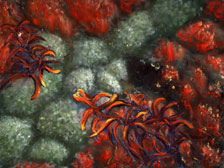 Sense of Smell Two;Red and White Olfactory Garden, 18" x 24", mixed media, 2002. Prints In Stock
Sense of Smell Two;Red and White Olfactory Garden, 18" x 24", mixed media, 2002. Prints In Stock
Available for Purchase $1,700 (framed).The Sense of Smell series uses the textures and imagery of electron microscope* pictures of human olfactory neurons as inspiration and foundation underneath the painting. The olfactory tissue consists of supporting cells and receptor cells. The receptor cells have many tendrils, like the central red creeping shapes, which seem to beckon scent molecules as they float by. Golden flakes of aroma waft across the painting.
*Electron micrograph of olfactory neurons supplied by Dr. Richard Costanzo.
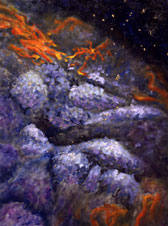 Sense of Smell Three; Purple Olfactory Garden, 18" x 24", mixed media, 2002. Prints In Stock
Sense of Smell Three; Purple Olfactory Garden, 18" x 24", mixed media, 2002. Prints In Stock
Private Collection.The Sense of Smell series uses the textures and imagery of electron microscope* pictures of human olfactory neurons as inspiration and foundation underneath the painting. The olfactory tissue consists of supporting cells and receptor cells. The receptor cells have many tendrils, like the orange strands, which seem to beckon scent molecules as they float by. Golden flakes of aroma waft across the painting*Electron micrograph of olfactory neurons supplied by Dr. Richard Costanzo.
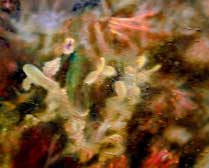 Sense of Smell Four ; Yellow Olfactory Garden, 18" x 24", mixed media, 2002. Available for Purchase $1,700 (framed)The Sense of Smell series uses the textures and imagery of electron microscope* pictures of human olfactory neurons as inspiration and foundation underneath the painting. The olfactory tissue consists of supporting cells and receptor cells, which have been transformed into these red and yellow flowers.
Sense of Smell Four ; Yellow Olfactory Garden, 18" x 24", mixed media, 2002. Available for Purchase $1,700 (framed)The Sense of Smell series uses the textures and imagery of electron microscope* pictures of human olfactory neurons as inspiration and foundation underneath the painting. The olfactory tissue consists of supporting cells and receptor cells, which have been transformed into these red and yellow flowers.
Electron micrograph of olfactory neurons supplied by Dr. Richard Costanzo.
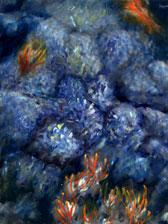 Sense of Smell Five;Blue Olfactory Garden, 18" x 24", mixed media, 2002. Prints In Stock
Sense of Smell Five;Blue Olfactory Garden, 18" x 24", mixed media, 2002. Prints In Stock
Available for Purchase $1,700 (framed).The Sense of Smell series uses the textures and imagery of electron microscope* pictures of human olfactory neurons as inspiration and foundation underneath the painting. The olfactory tissue consists of supporting cells and receptor cells. The receptor cells have many tendrils, like the orange strands, which seem to beckon scent molecules as they float by. Golden flakes of aroma waft across the painting.
Electron micrograph of olfactory neurons supplied by Dr. Richard Costanzo.
Sage-scented Oil for a Mycenaean Tree Goddess, mixed media, 24" x 33", 2002. Private Collection. Prints available.
These two Mycenaean women are engaged in their sage-scented ritual at the base of an olfactory neuron carved into the shape of a tree.
Electron micrograph of olfactory neurons supplied by Dr. Richard Costanzo from the article Morrison EE, Costanzo RM. "Morphology of the human olfactory epithelium." Morrison EE, Costanzo RM., J Comp Neurol. 1990 Jul 1;297(1):1-13. Also based on information from "Mycenae and the Mycenaean Age" by George E. Mylonas, 1966, Princeton University Press.
To See the Patterns of Smell, mixed media, 24" x 33", 2002. Available for purchase. Prints available. $1,600 framed.
The woman in this painting is visually immersed in a handful of smells, such as from a bouquet of flowers. The cliffs and surface she walks upon are olfactory neurons, with an ocean of connections to the brain below. Every smell we perceive is carried into our noses and binds to olfactory receptors there. Our noses have a field of about 1000 different types of smell receptors, yet we can smell about 10,000 scents. Each scent may stick to more than one kind of receptor, as different areas of the scent molecule may be able to attach to different receptors. Via these receptors and the neurons that transfer their information to the glomeruli of the brain, each scent forms a particular pattern that the brain interprets as a particular scent.
Electron micrograph of olfactory neurons supplied by Dr. Richard Costanzo from the article Morrison EE, Costanzo RM. "Morphology of the human olfactory epithelium." Morrison EE, Costanzo RM., J Comp Neurol. 1990 Jul 1;297(1):1-13. Also inspired by article and images in "Visualizing an Olfactory Sensory Map", by Mombaerts P, Wang F, Dulac C, Chao SK, Nemes A, Mendelsohn M, Edmondson J, Axel R., Cell. 1996 Nov 15;87(4):675-86, and the review "The Molecular Logic of Smell", by Axel R., Sci Am. 1995 Oct;273(4):154-9.
Obsession for Fragrance, mixed media, 32" x 28", 2002. Available for purchase. Prints available. $2,300 (framed).
An Ancient Greek is carried away by the scent coming from a perfume vessel deep into a world of olfactory neurons. The ancient Greeks were passionate about perfumes and scented oils. The Greek addiction to perfume prompted Solon, a ruler in Athens 594 B.C., to create a law prohibiting the sale of perfume.
Electron micrograph of olfactory neurons supplied by Dr. Richard Costanzo. Solon information from "Scents of Time - Perfume from Ancient Egypt to the 21st Century", The Metropolitan Museum of Art, Bulfinch Press, 1999. ISBN 0-87099-898-6.